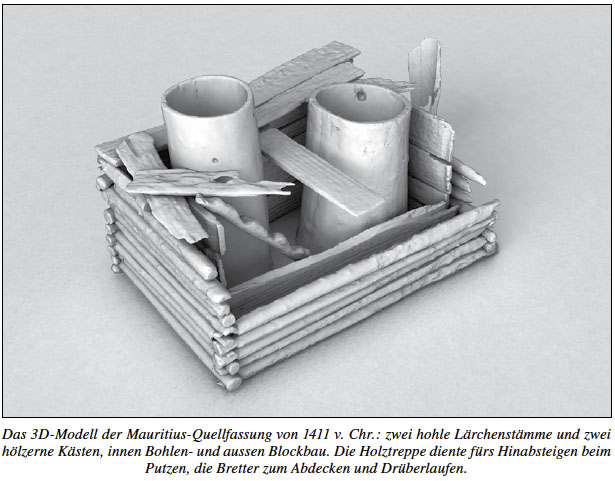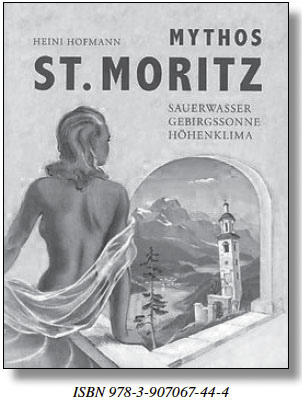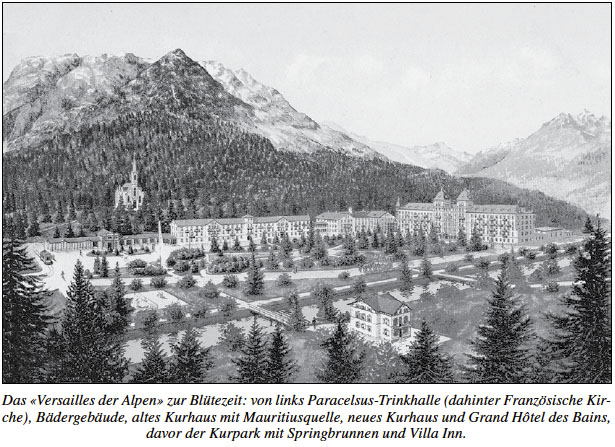The tapping of the St. Moritz fountain – the oldest wooden building in Europe
The tapping of the St. Moritz fountain – the oldest wooden building in Europe
The old lady’s unfinished odyssey
by Heini Hofmann
In spring of the year 1411 BC, which is more than 200 years prior to Moses and his people abandoning Egypt, respectively 700 years prior to the foundation of Rome, original inhabitants of the Engadine built a fountain tapping which is of special interest again today.
Not only is it the oldest wooden building in Europe, but it is one of the most important alpine prehistoric finds, as it contained the earliest known, highest situated mineral spring in Europe, which would later catapult the small farming settlement of San Murezzan right up so as to become the prestigious global village of St. Moritz.
In the beginning was the water
So the Upper Engadine skiing eldorado and summer tourism paradise of today became famous thanks to the healing spring water. Hotels and sports were after-effects.
But as later on the sole focus was placed upon sports, the once world-renowned spa tradition has fallen into oblivion. Today, one is hardly any longer aware of this former pacemaker. This is clearly shown in an official village talk given on “St. Moritz – then and now”. Water as the primary promoter was not even mentioned.
And it is hardly comprehensible that St. Moritz has years ago surrendered nothing less than its central element to a Russian investor, whose name is not laid open. This concerns the entire spa area together with the famous St. Mauritius Fountain, which former crowned heads used to pilgrim to. For now, precisely when tourism is stagnating and additional economic mainstays are urgently needed, a modern revival of the medical water spa would be indicated so as to reactivate that tourism sector which once ensured the leading role for the place in all of Europe, not for 150 years like with winter sports, but for almost three and a half thousand years! There is no other health resort in the world with a tradition reaching even roughly as far as that.
Crests and throughs of water waves
But the chronicle of this source has always been a continual roller-coaster of light and shadow. It experienced heydays of healing water use as well as total neglect, but fortunately also repeated rescue at the last minute by farsighted persons. It became world famous in the Middle Ages, first when Medici Pope Leo X organized processions to the well, and then when Paracelsus, the greatest physician of his century, praised this acidulous spring as the best in Europe. As early as in the 17th/18th century a massive flow of spa patients set in. Finally, in the 19th century, St. Moritz soared to become an internationally famous health resort with a Belle Epoque hotel boom and a sophisticated spa clientele.
Deep economic wave troughs were caused by the two world wars and in the end by the fact that the spa tradition was neglected and facilities became obsolete because of a partial preference for sports. The world famous Mauritius soure, which is the only one still active today, is leading a sad, locked up, and incarcerated existence. Ten years ago experts already pointed out its technically precarious condition. The Paracelsus fountain is buried, the Surpunt source is closed and currently the health spa, the last active witness of the once glorious spa tradition, is at risk.
History as an obligation
The odyssey of the tapping of the Mauritius source is truly a symbol for the overall development of the concept of the spa. In 1853, on the occasion of a reconstruction of the St. Mauritius fountain, one came across the wooden original version of the tapping of this highest mineral source created by original inhabitants of the Engadine. It consisted of two hollowed larch trunks, surrounded by two wooden boxes, which consisted of a plank construction inside and a log construction outside. First this was just cleaned up. Only when the spring was newly rimmed in 1907 the entire construction was lifted. At that time Professor J. Heierli estimated it correctly as stemming from the Bronze Age. But from then on this spring rim led a downtrodden existence in the basement of the Engadine Museum.
In 1995, the Archaeological Service Grisons started a first and in 1998 a successful second attempt at dating it (using dendrochronology and the C14 method). The result was amazing, 1466 BC! Therefore this almost 3,500 years old tapping of a spring is a very special historic building, namely the oldest and best preserved prehistoric building made of wood in the whole of Europe! This creates an obligation, and so it was decided to put this treasure on exhibition in the restored Forum Paracelsus. For at the Mauritius source, where it actually belongs, it would have ended up imprisoned underground again ...
Putting the cart before the horse
But first one wanted to provide it with a facelift. For this purpose the old lady went on a long journey from St. Moritz to the Swiss National Museum collection centre in Affoltern am Albis in 2013, accompanied by a young lady, the archeologist Monika Oberhänsli. As part of her master’s thesis she carefully examined the 117 wooden pieces from a variety of angles, including the creation of a 3D model and a renewed exact age determination. And behold, the old lady, now dated at 1411 BC, became 55 years younger …. In June 2014, it returned to St. Moritz and found its temporary abode in the renovated Forum Paracelsus.
This is gratifying, but it is not enough for revitalisation. While two historic witnesses, the former Paracelsus drinking hall and the Bronze Age tapping of the Mauritius spring, already shine in new glamour, the two still active main protagonists of the St. Moritz spa tradition, the Mauritius Source and the spa, are still waiting for their revival. So the carriage is put before the parade horse of the St. Moritz spa tourism, and this is not enough to move on with the success story. This opportunity has yet to be seized. The fact is that, parallel to the demographic trend (increasing average age), health and wellness tourism are growing and are also more crisis-proof than holiday and sports tourism.
Lack of a master plan
The current problem throughout the spa theme is self-explanatory. A functioning spa system is based on a necessarily connected of source, medical wellness and spa hotel, because guests want to board on the spot. But this is exactly what does not work anymore, as the original Grandhôtel des Bains (today’s Hotel Kempinski) has – fortunately for St. Moritz - developed into a five-star luxury hotel, but because of this, however, does not fit together with the spa any longer, notwithstanding that they formerly used to be Siamese twins. It seems to be somewhat tragicomical that underground, source engineers are striving to achieve a clean separation of groundwater and spring water and above ground, champagne and mineral water come too close to each other ...
What ought to be done? The locked up Mauritius source ought to be fairy kissed from its sleeping beauty existence and turned back into a main sightseeing attraction for tourists and locals alike. This would entail that the restored spring enclosure would be allowed to end its odyssey at its original place. Indeed the source mainly became famous because of the stunning aha-moment you have while you enjoy drinking directly from the source. Because it is supersaturated carbonic acid water, it sparkles even more extremely than champagne when you drink it directly from the source. However, this effect falls flat when drinking fountains with long water feed lines are used.


Hope is the last to die
Also the health spa directly above or at the source which is fed by this would necessarily have to be modernized and expanded into a medical competence center with broad support (exploitation of synergy effects that are already threatened with being frittered away). Should the Grand Hôtel des Bains not decide to go along, a spa hotel would have to make up the necessary trilogy. Moreover, a clever grouping of the buildings in accordance with the original concept might allow the park belonging to the baths to gain in size again.
Although concrete ideas do exist and the inhabitants signaled great interest at an event, all efforts in this direction have failed up to now, however, due to a lack of overall concept stemming from the fact that the community no longer has the final word on the baths area. Therefore, many locals and newcomers are wondering whether the Russian investor who so obviously has a great flair for St. Moritz, does understand about the historical context and is informed of today’s opportunity for a modern revival of the former «Versailles of the Alps». Who’s to say? The Russian soul is well known for its great flair for history and culture. •
Images from the book: Hofmann, Heini. Mythos St. Moritz. Sauerwasser – Gebirgssonne – Höhenklima. (The Myth of St. Moritz. Acid Water - Mountain Sun - Mountain Climate) by Heini Hoffmann. Montabella-Verlag, St. Moritz, 2014.
(Translation Current Concerns)
Water – the mistaken Engadine natural resource
Water is increasingly becoming a global issue and is now even decisive for the preservation of world peace. While others have to fight for the “right to water”, nature has blessed the Engadin abundantly with it.
The high Alpine valley owes its beauty last not least to the liquid gold in all its different states of aggregation, as water, snow, firn and ice. And, it has become famous thanks to its spas; they are the ones who laid the foundations for the touristic high.
That is an obligation! The Engadine as “Europe’s water castle” and springwaterblessed “Terra sana” has to get conscious of this asset again. On the one hand, to benefit itself, but also, richly endowed, to take responsibility for this precious natural resource.
